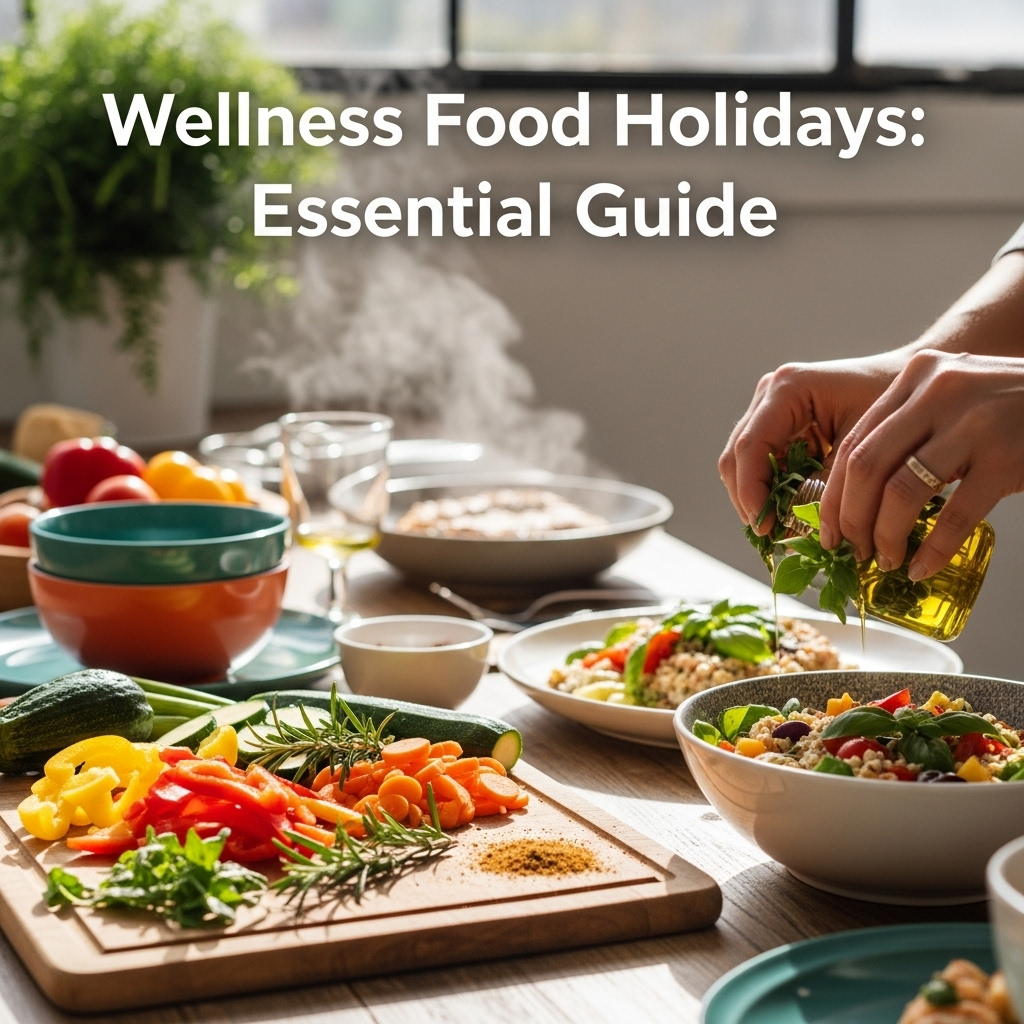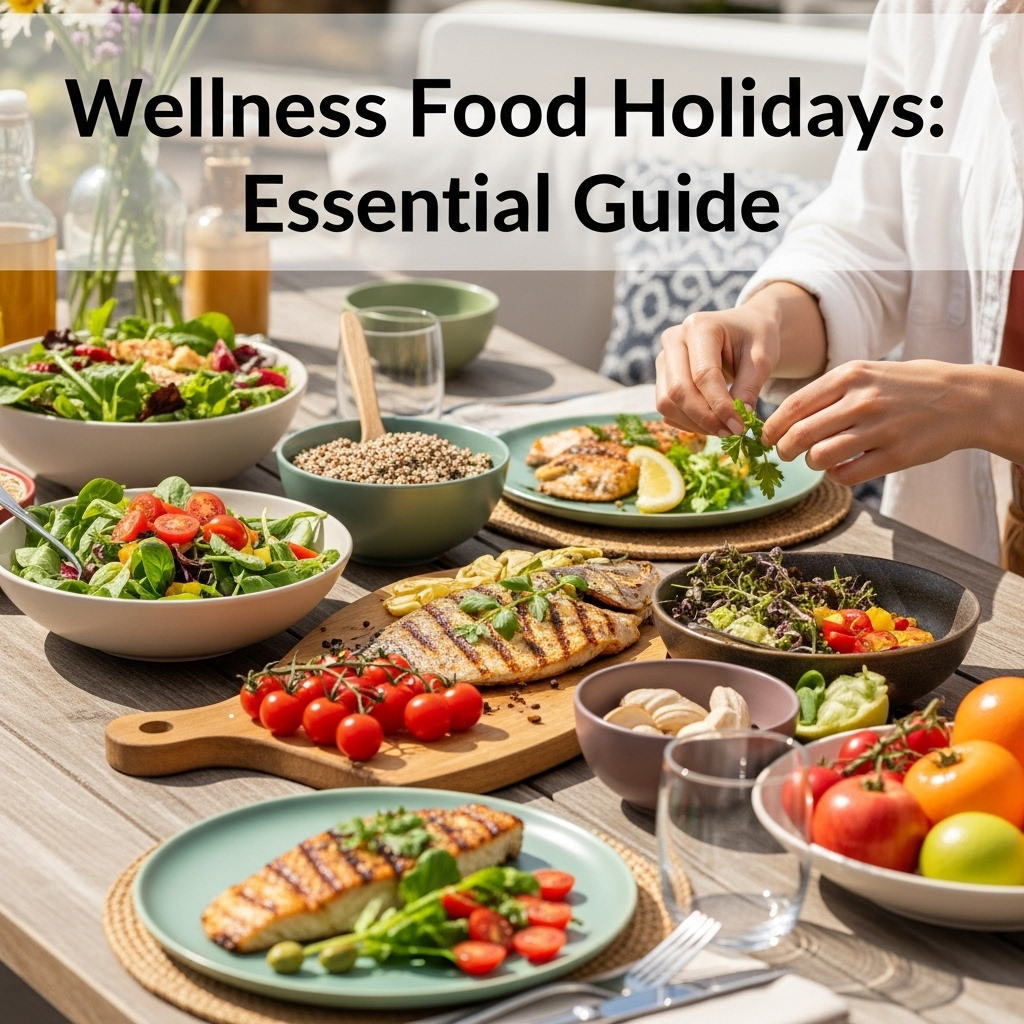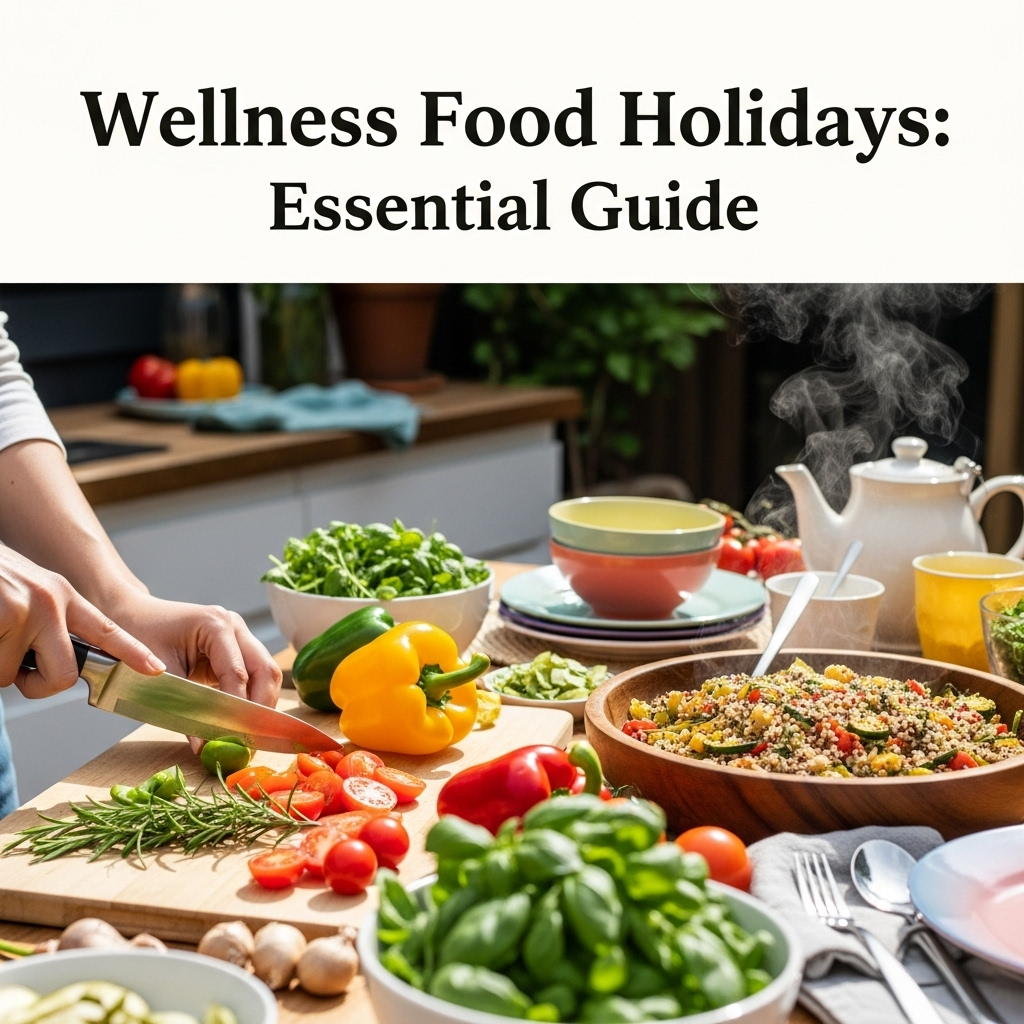Unlock a healthier way to celebrate with wellness food holidays! This guide simplifies making delicious, nutrient-packed choices during special occasions, turning mealtime worries into joyful, nourishing traditions for everyone. Discover easy tips and festive ideas to enjoy every bite, guilt-free.
Hey there, fellow kitchen explorers! It’s Joseph Bryant from FoodsGuider, where we make delicious food adventures accessible to everyone. Ever feel a little… overwhelmed when holidays roll around? Visions of rich, comforting meals dance in our heads, but sometimes they come with a side of guilt or tummy troubles. It’s totally normal to want to enjoy festive flavors without feeling sluggish afterward. The good news? You absolutely can! We can savor every moment and every delicious bite with a few smart tweaks and a dash of creativity. Get ready to transform your holiday eating from a source of stress into a celebration of vibrant, wholesome goodness. We’ll dive into simple strategies that make wellness food holidays a breeze, ensuring your taste buds are happy and your body feels fantastic.
What Are Wellness Food Holidays?
Wellness food holidays are essentially designated times, either official calendar dates or personal choices, to focus on nourishing your body with wholesome, health-promoting foods during celebratory periods or throughout the year. Think of them as opportunities to enjoy delicious meals that also make you feel good, both inside and out. It’s not about restrictive diets or deprivation; it’s about making conscious, positive food choices that support your well-being while still embracing the joy and spirit of any occasion. These holidays encourage a balanced approach to eating, emphasizing fresh ingredients, mindful preparation, and celebratory meals that fuel rather than drain you.
Why Focus on Wellness Food Holidays?

Life is full of special moments – birthdays, anniversaries, cultural celebrations, and of course, traditional holidays like Thanksgiving, Christmas, and New Year’s. Traditionally, these occasions are often centered around abundant, sometimes heavy, meals. While delicious, these can leave us feeling overstuffed, tired, and less than optimal. Focusing on wellness food holidays allows us to:
- Boost Energy: Enjoy meals that provide sustained energy, keeping you vibrant and engaged throughout holiday festivities.
- Improve Digestion: Opt for foods that are gentler on your digestive system, reducing bloating and discomfort.
- Support Overall Health: Incorporate nutrient-dense foods that contribute to your long-term well-being.
- Reduce Holiday Stress: By planning ahead and having go-to recipes, you can alleviate the pressure of “what to eat” during busy times.
- Enjoy Inclusively: Create dishes that cater to various dietary needs and preferences, ensuring everyone can join the feast joyfully.
- Cultivate Mindfulness: Encourage a mindful approach to eating, appreciating the flavors and the nourishment each meal provides.
Planning Your Wellness Food Holiday Strategy
The key to a successful wellness food holiday is thoughtful planning. Without a plan, it’s easy to get swept up in traditional indulgence. Here’s how to set yourself up for delicious success:
1. Define Your “Wellness” Goals
Before digging into recipes, consider what “wellness” means to you during this holiday. Are you aiming for:
- More plant-based meals?
- Reduced sugar intake?
- Increased fiber?
- Gluten-free options?
- Mindful portion sizes?
- Incorporating more lean protein?
Having clear goals helps guide your food choices and recipe selections. It’s about small, achievable steps rather than a complete overhaul.
2. Assess the Occasion
Is it a casual family gathering or a formal dinner party? Is it a potluck where you’re bringing a dish, or are you hosting? Understanding the context helps determine your role and what you can realistically contribute or prepare. For potlucks, bringing a healthy, crowd-pleasing dish is a fantastic way to ensure there’s at least one wellness option.
3. Embrace Smart Swaps
Many traditional holiday dishes can be made healthier with simple ingredient substitutions. Think of these as delicious upgrades, not sacrifices! Here are some ideas:
- For creamy sauces/soups: Use pureed vegetables (like cauliflower or butternut squash), unsweetened almond or cashew milk, or a roux made with whole-wheat flour and olive oil.
- For refined sugar: Opt for natural sweeteners like maple syrup, honey, date paste, or fruit purees in moderation.
- For white flour: Choose whole wheat flour, almond flour, oat flour, or a gluten-free blend for baking and thickening.
- For butter/oil: Use olive oil, avocado oil, or even unsweetened applesauce in some baked goods.
- For heavy cream: Explore coconut milk (full-fat for richness, light for less fat), blended silken tofu, or mashed avocado.
4. Focus on Flavor-Packed Ingredients
Healthy eating doesn’t mean bland eating! Herbs, spices, citrus zest, garlic, onions, and vinegars are your best friends. They add depth and complexity without adding unhealthy fats or sugars. Roasting vegetables caramelizes their natural sugars, bringing out incredible sweetness and flavor. A squeeze of lemon or lime can brighten up almost any dish.
5. Prepare Ahead
The more you can prep in advance, the less stressed you’ll be on the day of the celebration. Wash and chop vegetables, make dressings or sauces, bake grains, or even assemble casseroles. This allows you to simply reheat or assemble components when it’s time to cook.
Essential Wellness Food Holiday Recipes & Ideas

Let’s get cooking! Here are some versatile ideas that can be adapted for various holidays and dietary needs. These are designed to be approachable, delicious, and genuinely satisfying.
Appetizers & Starters
Kick off your celebration with light, flavorful bites that won’t spoil your appetite.
- Caprese Skewers: Cherry tomatoes, fresh mozzarella balls, and basil leaves drizzled with balsamic glaze. Simple, fresh, and always a hit.
- Hummus Platter: Store-bought or homemade hummus served with a colorful array of fresh vegetables like carrot sticks, cucumber slices, bell pepper strips, and snap peas. Add some whole-wheat pita bread or gluten-free crackers.
- Shrimp Cocktail: A classic for a reason! Opt for a homemade cocktail sauce with less sugar and more horseradish.
- Stuffed Mushrooms: Mushrooms filled with a mixture of herbs, garlic, finely chopped spinach, and a sprinkle of Parmesan cheese.
- Mini Sweet Potato Bites: Roasted sweet potato rounds topped with avocado, black beans, and a pinch of chili powder.
Main Courses
The star of the show should be both nourishing and delicious. Consider these options:
- Roasted Turkey or Chicken with Herbs: A classic that can be made healthier by seasoning generously with fresh herbs like rosemary, thyme, and sage, garlic, lemon, and minimal salt. Stuff the cavity with aromatics like onions and leeks for moisture and flavor instead of bread.
- Baked Salmon with Lemon-Dill Sauce: Salmon is rich in omega-3 fatty acids. Bake it with lemon slices and fresh dill. A light sauce made with Greek yogurt or pureed avocado can replace heavier cream-based sauces.
- Lentil Loaf: A fantastic vegetarian or vegan centerpiece. This can be made with lentils, mushrooms, oats, vegetables (like carrots, celery, onions), and herbs. Top with a sugar-free tomato glaze.
- Stuffed Bell Peppers: Bell peppers filled with a mixture of quinoa or brown rice, lean ground turkey or black beans, corn, diced tomatoes, and seasoned with spices.
- Hearty Vegetable Stew: A comforting and filling option for cooler weather, packed with root vegetables, legumes, and savory herbs. Serve with crusty whole-grain bread.
Side Dishes
These are where you can really pack in the nutrients!
- Roasted Root Vegetables: Carrots, parsnips, sweet potatoes, and beets tossed with olive oil, rosemary, thyme, and a pinch of salt and pepper. Roasting brings out their natural sweetness.
- Green Bean Almondine (Healthier Version): Sautéed green beans with slivered almonds. Use olive oil instead of butter and keep the portioning mindful.
- Quinoa Salad with Cranberries and Pecans: A flavorful and filling alternative to traditional stuffing. Cooked quinoa tossed with dried cranberries, toasted pecans, chopped celery, and a light vinaigrette.
- Cauliflower Mash: A lower-carb alternative to mashed potatoes. Steam or boil cauliflower until tender, then mash or blend with a little garlic, unsweetened almond milk, and a touch of olive oil.
- Brussels Sprouts with Balsamic Glaze: Roasted Brussels sprouts are wonderfully crispy. Toss with a little olive oil and a drizzle of balsamic glaze towards the end of cooking.
Desserts
You don’t have to skip dessert! Focus on fruit-forward or naturally sweetened options.
- Baked Pears or Apples: Core pears or apples, fill with a mixture of oats, cinnamon, and a few chopped nuts, then bake until tender. Drizzle with a touch of maple syrup if desired.
- Fruit Salad with Mint: A refreshing mix of seasonal fruits, enhanced with fresh mint leaves.
- Chia Seed Pudding with Berries: Naturally thickened and packed with fiber and omega-3s. Make ahead and top with fresh berries.
- Dark Chocolate Avocado Mousse: Creamy and decadent, using avocado for texture and healthy fats. Sweeten with dates or a touch of maple syrup.
Wellness Food Holiday Celebrations: A Closer Look
Let’s dive into some specific holiday examples and how to adapt them for wellness.
Thanksgiving
This is a prime candidate for wellness focus! Instead of a turkey drowned in gravy and starchy stuffing, consider:
| Traditional Dish | Wellness Swap/Idea | Why It Works |
|---|---|---|
| Creamy Green Bean Casserole | Sautéed green beans with mushrooms and a lighter cashew cream sauce or a sprinkle of toasted almonds. | Reduces processed ingredients, heavy cream, and fried onions. Adds healthy fats and fiber. |
| White Bread Stuffing | Quinoa or wild rice stuffing with lots of vegetables (celery, onion, carrots, apples) and herbs. | Increases fiber and nutrients, lowers refined carbohydrates. |
| Sweet Potato Casserole with Marshmallows | Roasted sweet potato rounds topped with cinnamon, walnuts, and a drizzle of maple syrup. Or a savory version with herbs. | Reduces added sugar and processed ingredients, highlights natural sweetness. |
| Gravy | Make a lighter gravy using the pan drippings, thickened with a cornstarch slurry or pureed vegetables, and seasoned well with herbs. | Controls sugar and fat content, uses whole-food thickeners. |
Christmas
Christmas often involves rich, decadent foods. Think about incorporating lighter, yet festive, elements.
- Appetizers: A vibrant crudités platter with homemade spinach-artichoke dip (using Greek yogurt and white beans) or spicy roasted chickpeas.
- Main Dish: Baked salmon with a pomegranate-glaze or a hearty vegetable Wellington.
- Sides: A festive salad with pomegranate seeds, oranges, and a light citrus vinaigrette. Brussels sprouts roasted with cranberries and a touch of maple syrup.
- Dessert: Gingerbread cookies made with whole wheat flour and molasses, or baked apples stuffed with dried fruit and nuts.
New Year’s Eve/Day
A time for fresh starts! Use New Year’s as a prompt to embrace lighter, healthier eating.
- Lucky Foods Focus: Many cultures have “lucky” foods for the New Year. Adapt these traditionally: For instance, if black-eyed peas are lucky, make a fresh, vibrant black-eyed pea salad with corn, bell peppers, and a lime dressing instead of a heavy, fried version.
- Detoxifying Meals: Serve plenty of leafy greens, whole grains, and lean proteins. A large “Buddha bowl” packed with roasted vegetables, a grain like farro or brown rice, and a tahini dressing is a great option.
- Healthy Cocktails/Mocktails: Mix up sparkling water with muddled fruit and herbs, or invest in fresh juices for creative mocktails. For alcoholic options, stick to simple spirits with soda water and a twist of lime.
Tips for Healthy Holiday Potlucks

Potlucks can be tricky! Here’s how to navigate them healthily:
- Communicate: If you’re coordinating, suggest a theme or ask who’s bringing what to ensure variety and a balance of healthier options.
- Bring a Star Dish: Offer to bring a “wellness” staple like a large vibrant salad, roasted vegetables, a quinoa dish, or a fruit platter. This guarantees you have something healthy to eat.
- Be Mindful of Portions: Fill your plate with the healthier options first, then add smaller portions of richer dishes if you choose.
- Hydrate Wisely: Drink plenty of water. Sometimes thirst can be mistaken for hunger.
- Focus on Connection, Not Just Food: Engage in conversations and activities, shifting the focus from constant eating to the overall enjoyable experience.
Leveraging Superfoods and Nutritional Powerhouses
Incorporate nutrient-dense “superfoods” to boost the health factor of your holiday meals. These foods are packed with vitamins, minerals, antioxidants, and healthy fats.
- Berries (Blueberries, Raspberries, Strawberries): Excellent antioxidants, vitamins, and fiber. Perfect for desserts, salads, or as garnishes.
- Leafy Greens (Spinach, Kale, Swiss Chard): Packed with vitamins A, C, K, and iron. Use them in salads, sautéed side dishes, or blended into sauces and dips.
- Nuts and Seeds (Almonds, Walnuts, Chia Seeds, Flaxseeds): Provide healthy fats, protein, and fiber. Great for adding crunch to salads, topping dishes, or incorporating into baked goods. For more on the benefits of nuts, check out resources from the National Agricultural Library.
- Legumes (Lentils, Beans, Chickpeas): Fantastic sources of protein, fiber, and complex carbohydrates. Use them in soups, stews, salads, or as meat substitutes.
- Whole Grains (Quinoa, Farro, Brown Rice, Oats): Provide sustained energy, fiber, and essential nutrients. Use them as side dishes, in stuffings, or as bases for grain bowls.
- Avocado: Rich in monounsaturated fats, potassium, and fiber. Great for dips, dressings, desserts, or as a healthy topping.
Mindful Eating During Holidays

Beyond the food itself, the way we eat matters. Practicing mindful eating can enhance your enjoyment and help you feel more satisfied.
- Slow Down: Take smaller bites and chew thoroughly. It takes about 20 minutes for your brain to register that you’re full.
- Savor Each Bite: Pay attention to the flavors, textures, and aromas of your food.
- Listen to Your Body: Eat when you’re hungry and stop when you’re comfortably full, not stuffed.
- Minimize Distractions: Try to eat without screens or excessive multitasking to better appreciate your meal.
- Appreciate the Source: Take a moment to consider where the food came from and the effort that went into preparing it.
Frequently Asked Questions About Wellness Food Holidays
Q1: Is it okay to eat traditional holiday foods sometimes?
A1: Absolutely! Wellness food holidays are about balance, not perfection. It’s perfectly fine to enjoy traditional favorites in moderation. The goal is to make conscious choices more often, not to eliminate indulgence entirely.
Q2: How can I make my holiday desserts healthier without sacrificing taste?
A2: Focus on natural sweeteners like fruit purees or maple syrup in smaller amounts. Use whole-wheat flour or almond flour. Incorporate fruit, nuts, and spices to add flavor and texture. Dark chocolate (70% cacao or higher) is also a great option in moderation.
Q3: My family is really set in their ways regarding holiday food. How can I introduce healthier options?
A3: Start small. Introduce one or two healthier dishes to the table, like a vibrant salad or roasted vegetables. You can also offer to bring a healthier